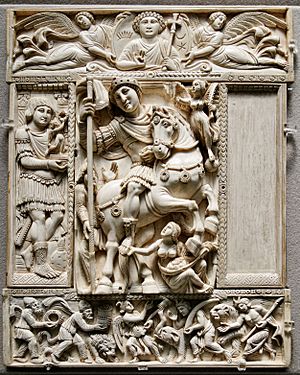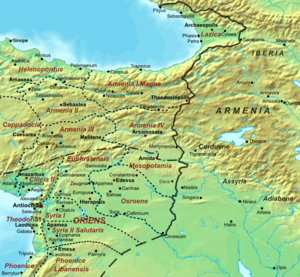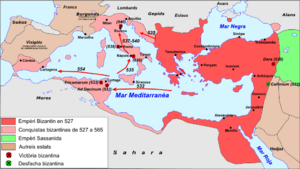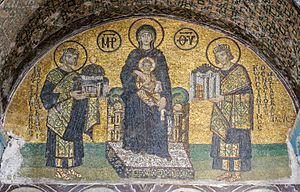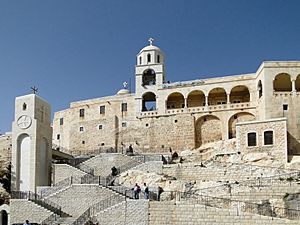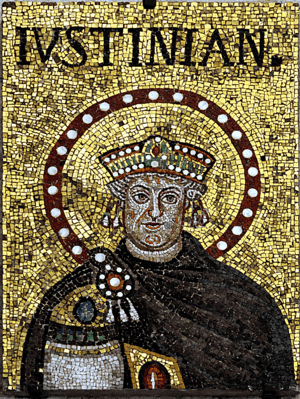Justinian I facts for kids
Quick facts for kids Justinian I |
|||||||||
|---|---|---|---|---|---|---|---|---|---|
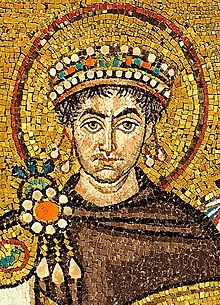
A mosaic of Justinian in Ravenna, made in 547 AD.
|
|||||||||
| Byzantine emperor | |||||||||
| Augustus | 1 April 527 – 14 November 565 | ||||||||
| Coronation | 1 April 527 | ||||||||
| Predecessor | Justin I | ||||||||
| Successor | Justin II | ||||||||
| Born | Petrus Sabbatius 482 Tauresium, Dardania |
||||||||
| Died | 14 November 565 (aged 83) Constantinople |
||||||||
| Burial | Church of the Holy Apostles | ||||||||
| Spouse | Theodora (m. 525; d. 548) | ||||||||
|
|||||||||
| Dynasty | Justinian dynasty | ||||||||
| Father | Sabbatius Justin I (adoptive) |
||||||||
| Mother | Vigilantia | ||||||||
| Religion | Chalcedonian Christianity | ||||||||
Justinian I (born in 482, died 14 November 565), also known as Justinian the Great, was a powerful Eastern Roman emperor. He ruled from 527 to 565. His main goal was to bring back the glory of the old Roman Empire. He wanted to "restore the Empire" by taking back lands that had been lost in the west.
Justinian's army, led by his famous general Belisarius, quickly conquered the Vandal Kingdom in North Africa. They also took back Italy, Sicily, and Rome from the Ostrogoths. His generals even reclaimed parts of the Iberian Peninsula (modern-day Spain). These victories brought back Roman control over the western Mediterranean Sea.
One of Justinian's most important achievements was rewriting Roman law. This new set of laws, called the Corpus Juris Civilis, is still the basis for civil law in many countries today. His time as emperor also saw a flourishing of Eastern Roman culture. He started many building projects, including the famous Hagia Sophia church.
Contents
Early Life and Rise to Power
Justinian was born in a place called Tauresium in 482. He grew up speaking Latin, which was unusual for later Roman emperors. He came from a simple farming family. His uncle, Justin I, adopted him and brought him to Constantinople. Justinian received a good education in law, religion, and history.
When Emperor Anastasius died in 518, Justin became the new emperor with Justinian's help. Justinian was very ambitious. He became the real ruler even before Justin officially made him co-emperor. In 525, Justinian was given important titles. He was crowned co-emperor on April 1, 527. When Justin died on August 1, 527, Justinian became the sole ruler.
As emperor, Justinian was very hardworking. People called him "the emperor who never sleeps." He was also friendly and easy to talk to. Around 525, he married Theodora. She was an actress and about 20 years younger than him. At the time, it was scandalous for an emperor to marry an actress. But Justinian's uncle had changed the law to allow it. Theodora became very influential in the empire's politics.
Justinian's rule was not always popular. Early in his reign, he almost lost his throne during a huge riot. A plot against him was also discovered later. Justinian got sick with the plague in the 540s but recovered. Theodora died in 548, possibly from cancer. Justinian lived almost 20 years longer than her. He died on November 14, 565, without children. His nephew, Justin II, became the next emperor.
Major Achievements
Reforming Roman Law
Justinian is most famous for his legal reforms. He completely rewrote all of Roman law. This had never been done before. This collection of laws is known as the Corpus Juris Civilis. It includes:
- The Codex Justinianeus: A collection of imperial laws.
- The Digesta or Pandectae: A summary of older legal writings.
- The Institutiones: A textbook explaining legal principles.
- The Novellae: New laws issued during Justinian's reign.
These laws were put together by a legal expert named Tribonian. The Corpus Juris Civilis became the foundation of law in the Byzantine Empire. It also spread to Western Europe and influenced many modern legal systems. Justinian's laws also showed more concern for children's rights. They protected children born outside of marriage and those who were abandoned.
The Nika Riots
Early in his reign, Justinian faced a huge rebellion called the Nika riots. This happened in January 532. People in Constantinople, especially fans of chariot racing teams, united against Justinian. They wanted him to fire some of his ministers. They even tried to replace him with a new emperor.
Justinian thought about running away from the capital. But his wife, Theodora, convinced him to stay. She famously said she would rather die as an empress than live as a refugee. So, Justinian ordered his generals, Belisarius and Mundus, to stop the riots. About 30,000 unarmed people were killed in the Hippodrome.
The riots caused a lot of destruction in the city. This gave Justinian a chance to rebuild. He started many grand new buildings, including the magnificent Hagia Sophia church.
Military Campaigns and Reconquests
One of Justinian's biggest goals was to take back lands that the Western Roman Empire had lost. He believed it was his duty as a Christian emperor to restore the Roman Empire to its old borders. Even though he didn't fight in battles himself, he was proud of his military successes. His general Belisarius led most of these campaigns.
War with the Sassanid Empire
Justinian inherited a war with the Sasanian Empire (Persians) in the east. After some battles, Justinian made a "Eternal Peace" treaty with the Persian king Khosrau I in 532. This peace cost him a lot of gold. With his eastern border secure, Justinian could focus on the west.
Conquering North Africa

Justinian first attacked the Vandals in North Africa. Their king had been overthrown, and Justinian saw this as a chance to intervene. In 533, Belisarius sailed to Africa with about 15,000 soldiers. They quickly defeated the Vandals in two battles. Belisarius captured their capital, Carthage. The Vandal king surrendered and was brought to Constantinople. This campaign also recovered Sardinia, Corsica, and the Balearic Islands.
War in Italy
Next, Justinian turned his attention to Ostrogothic Italy. In 535, Belisarius invaded Sicily and then Italy. He captured Rome in 536. The Ostrogoths tried to take Rome back but failed. Justinian sent another general, Narses, to Italy. After some struggles, Belisarius captured the Ostrogothic capital, Ravenna, in 540. He took the Ostrogothic king, Vitigis, back to Constantinople.
However, the war with the Persians started again in 540. King Khosrau I broke the peace treaty and invaded Roman territory. He sacked cities like Antioch. Belisarius was called back to the east. The war in Italy continued, and the Ostrogoths, led by their new king Totila, regained much of the peninsula.
Justinian sent Narses back to Italy with a large army. In 552, Narses defeated the Ostrogoths in a major battle, killing Totila. The Ostrogothic resistance was finally broken. By 554, Italy was secured for the Empire.
Other Campaigns
Justinian also sent troops to parts of Spain. They took Cartagena and other cities on the southeastern coast. This marked the greatest extent of the Byzantine Empire under Justinian.
The Balkans in the north faced attacks from Turkic and Slavic groups. Justinian used diplomacy and built defenses to protect the region. In 559, a dangerous invasion threatened Constantinople itself, but the old general Belisarius drove them back.
Justinian's dream of fully restoring the Roman Empire was only partly achieved. The wars were very expensive and drained the empire's resources. However, he did significantly expand the empire's territory and remove naval threats.
Religious Policies and Building Projects
Justinian believed that a strong empire needed a single, unified faith. He was a strong supporter of Chalcedonian Christianity. He tried to unite different Christian groups, especially the Monophysites in the eastern provinces. He also wrote some theological writings himself. His wife Theodora often supported the Monophysites.
Justinian protected the Church and its clergy. He gave monks the right to inherit property. He also rebuilt the famous Hagia Sophia church, which had been destroyed during the Nika riots. The new Hagia Sophia, with its huge dome and beautiful mosaics, became the most important church in Eastern Orthodoxy.
Justinian was a very active builder. Besides Hagia Sophia, he also rebuilt the Church of the Holy Apostles and the Church of Saints Sergius and Bacchus. He also built many fortifications along the empire's borders. He ensured Constantinople had enough water by building underground cisterns. He even built a new city near his birthplace, called Justiniana Prima.
In Justinian's time, important historians like Procopius and Agathias wrote about the empire. Poets also flourished.
Economy and Administration
The empire's economy mainly relied on farming. Trade was also very important. Goods were traded as far as England. Convoys of ships brought wheat and grains from Alexandria to Constantinople. Justinian built a large granary to store grain for the capital.
A very important luxury product was silk. It was imported and then processed in the empire. To protect silk production, Justinian gave a monopoly to imperial factories. He also tried to find new trade routes for eastern goods. In the 550s, two monks managed to smuggle silkworm eggs from Central Asia to Constantinople. This meant silk could be produced within the empire itself.
Gold and silver were mined in various parts of the empire. Justinian also worked to make tax collection more efficient. He tried to fight corruption in the provinces. These changes helped fund his many wars and building projects.
Despite these efforts, the empire faced challenges. The Plague of Justinian (541-543) killed many people. This led to a shortage of workers and higher wages. The long wars also put a heavy strain on the empire's money.
Natural Disasters
In the 530s, the empire experienced strange weather. The sun seemed dim and didn't give much heat. This led to a terrible famine in 535-536. These events might have been caused by a large volcanic eruption that put dust into the atmosphere.
Seven years later, in 542, a devastating outbreak of Bubonic Plague hit the empire. This was known as the Plague of Justinian. It killed millions of people. Justinian himself caught the plague but survived.
In July 551, a huge earthquake struck the eastern Mediterranean. It caused a tsunami. These events together killed more than 30,000 people.
Cultural Depictions
Justinian I has appeared in many works of art and literature.
- In Dante Alighieri's Divine Comedy, Justinian is a spirit in Heaven. He talks about his legacy and how he restored Rome.
- He is a major character in the 1938 novel Count Belisarius by Robert Graves.
- Justinian also appears in the 1939 time travel novel Lest Darkness Fall.
- The Glittering Horn: Secret Memoirs of the Court of Justinian is a 1958 novel about his court.
- He sometimes appears in the comic strip Prince Valiant.
- Justinian is played by Innokenty Smoktunovsky in the 1985 Soviet film Primary Russia.
- "Justinian's Crown" is a historical item in the popular 2020 computer game Crusader Kings 3.
Images for kids
-
Mosaic of Theodora, Justinian's wife.
-
The church of Hagia Sophia in Istanbul, built during Justinian's reign.
-
A consular diptych showing Justinian's full name (521 AD).
See also
 In Spanish: Justiniano I para niños
In Spanish: Justiniano I para niños


